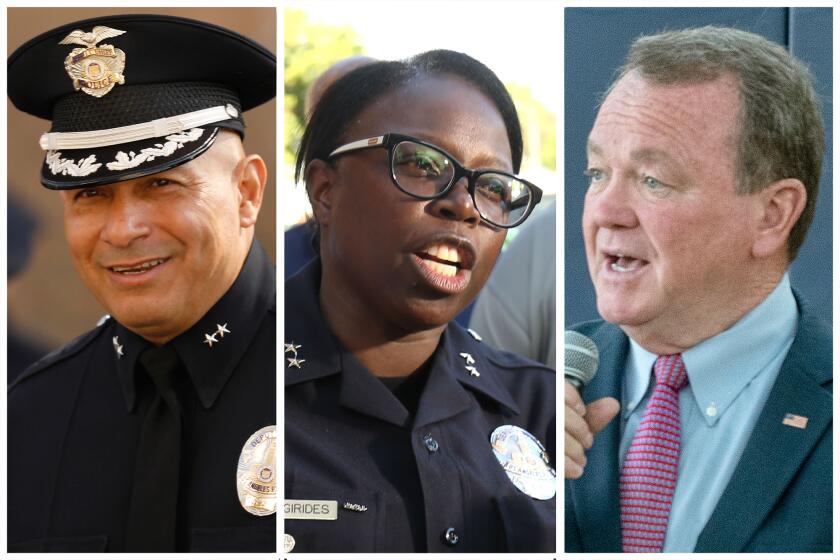LAPD’s careful preparations pay off
Hours before protesters kicked off pro-immigration marches Thursday, dozens of high-ranking Los Angeles Police Department officers gathered at a high-tech command center for a final planning session. In the middle of the meeting, Police Chief William J. Bratton unexpectedly stepped into the room, arms crossed, a stern look on his face.
“May 1st last year was an embarrassment for this department. It was the most embarrassing experience I’ve had in 38 years of policing,” he said, breaking the silence. “It will not be repeated today.”
The statement was partly an order from a chief determined not to have a repeat of last year, when police injured marchers and journalists during a badly botched effort to clear MacArthur Park. But it was also, he said, a reminder that he had confidence in the team that had been assembled to carry out an intricate crowd-control plan that was months in the making.
“We have a chance to redeem ourselves today,” he said. “To get our reputation back.”
By evening, after a few thousand people in three separate marches converged downtown for a rally, it looked as if the LAPD had taken a significant step toward doing just that. Hyper-prepared, unobtrusive and unfailingly polite to protesters, LAPD officers oversaw a May Day that featured more handshakes of appreciation than scowls of distrust.
“It’s the benefits of a good plan,” said Deputy Chief Michael Hillmann, the department’s incident commander, who has been very critical of last year’s debacle. “This is how it is supposed to be: no issues, no concerns.”
Hillmann was not leaving anything to chance. He ordered the department’s command center to be up and running at 6 a.m. By midmorning, it was a hive of activity, with aerial footage of the gathering crowd from LAPD helicopters projected onto large screens, alongside city maps and video feeds from cameras in MacArthur Park. “Listen up!” Hillmann called across the room at one point. “We’re doing a radio check to make sure we’re all working.”
Out on the streets, things also seemed to be running smoothly.
Four all-terrain vehicles fitted with high-powered speakers were used to convey directions in English and Spanish to the crowds. It was a notable improvement over last year, when commanders gave an order to disperse the MacArthur Park crowd but broadcast only in English and from a speaker on a noisy helicopter.
At the intersection of Olympic Boulevard and Broadway, where protesters were gathering, undercover officers in “shadow units” kept tabs on about a dozen “people of interest,” Hillmann said. Other officers in “extraction teams,” responsible for moving in quickly to make arrests, hung back unneeded and out of sight.
Keeping a low profile was a priority for Hillmann, who wanted to avoid a heavy-handed police presence. He deployed several hundred fewer officers than the 1,400 that were on the streets last year. And when the three marches converged at 5th Street and Broadway, the deputy chief ordered the dozens of officers escorting them to move farther up the street.
“Make the cops go away,” he ordered an aide. “I want as small a footprint as possible.”
Efforts by the LAPD didn’t go unnoticed by event organizers, who said it was a far cry from last year’s melee.
“Everything’s great; you guys are doing a great job,” Victor Narro, project director of the UCLA Labor Center, told Hillmann when the two crossed paths at MacArthur Park.
By midafternoon, Bratton’s stern demeanor of the morning had given way to a relaxed smile. He stepped out of Langer’s Deli near the park, waving to passing marchers. Many approached to shake hands and pose for photos.
“Right now,” he said, “I think we’re doing OK.”
--
More to Read
Sign up for Essential California
The most important California stories and recommendations in your inbox every morning.
You may occasionally receive promotional content from the Los Angeles Times.










